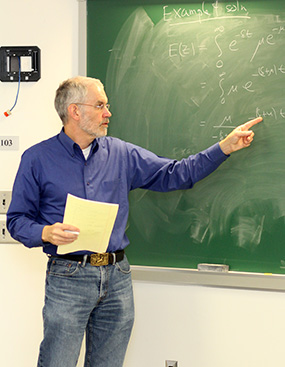In order to be a good chess player, a person has to think more than one move ahead, strategically analyzing possible outcomes. The next move made may not make sense at first – especially to those not playing – but in the long run, the decision will play out successfully.
That’s how one colleague describes the creation of Wabash College’s nationally-ranked actuary program, which was almost singlehandedly designed by Associate Professor of Mathematics Peter Thompson.
“Peter started thinking about ten moves ahead about ten years ago,” said Chad Westphal, Associate Professor of Mathematics and Computer Science. “Peter sort of single-handedly created this track that students can follow. It parallels the math major. They develop a broad enough base in mathematics that their degree is in mathematics, but they’ve specialized in financial mathematics. Actuarial science is a major thread through that.”
 Actuarial science deals with risk management and quantification and is most commonly known as what is used to determine insurance policies. But to become an actuary, one must successfully pass ten different exams; it is often recommended to spend approximately 300 hours studying for each exam. Many students are able to enter the field as an actuarial intern after they pass the first two exams, which can often be done while still in school.
Actuarial science deals with risk management and quantification and is most commonly known as what is used to determine insurance policies. But to become an actuary, one must successfully pass ten different exams; it is often recommended to spend approximately 300 hours studying for each exam. Many students are able to enter the field as an actuarial intern after they pass the first two exams, which can often be done while still in school.
“Mathematical Finance was becoming an important area of mathematics, and it was worthwhile to offer a course in it,” Thompson explained.
Wabash offers courses that correlate to the first three exams even though it does not offer actuarial sciences as a major. Instead, Thompson helped create the financial mathematics program within the mathematics major, and students can tailor their studies to help lead them into the career field of actuarial sciences.
“We’re the right size school and department to be able to move in a different direction,” Westphal said. “If we were in a great big department with lots of bureaucracy and red tape, it would be really hard to create something new.”
Thompson said creating the program did present some challenges, and some compromises did need to be made within the department. He designed everything as half courses to ensure adequate content coverage and multiple entry points for students getting into the program.
Like the successful chess player, Thompson’s efforts have paid off. Considering the program is not a major, and the creation of the financial mathematics program did not add any faculty members to the department, it is quite an accomplishment that Wabash’s actuary program was recently ranked No. 1 in the nation by SafeCo Insurance.
What makes the program so successful? The mastermind behind it all: Peter Thompson.
“I prepared for and took actuarial and other financial exams to gain expertise in actuarial science, mathematical finance, finance in general, and insurance to help me in running the financial math program,” Thompson said.
In fact, Thompson is only three exams away from becoming a licensed actuary. And he did it solely for the betterment of his students and this program.
“It’s really quite remarkable that he’s invested his professional energies into this,” Westphal said. “So he can speak with great authority, and he shares all of his notes and everything. Over the course of these last eight or ten years, he’s added in his own expertise in particular to actuarial studies and, very quietly but very consistently, he’s shepherded students through taking the actuarial exams.”
One of the students Thompson currently works with is Kenny Cox ’19. Cox is in his second half-semester course with Thompson and is preparing to take an actuarial exam in January. Along the way, Thompson has provided him with exam materials and networking information.
“Dr. Thompson's classes force you to learn the material without requiring hours upon hours of assignments,” Cox said. “The courses seem to focus more on learning the material than doing work. Homework is never assigned, but quizzes are given weekly. I learn a lot from his classes, but I rarely become stressed due to the class. I absolutely enjoy the program thus far.”
But Thompson does not take full credit for the surprising success of this program. Instead, he credits everyone else around him and related mathematics programs.
“I did not anticipate the large class sizes or the large numbers of majors,” he said, “but these are primarily due to a popular and supportive economics program and to the other mathematics faculty for growing mathematics majors in Calculus II and Linear Algebra.
“Program quality can be measured in a variety of ways – quality of curriculum, faculty expertise, popularity, student accomplishments, graduation rate, post-graduate success,” Thompson continued. “All of these are important for a successful program.”